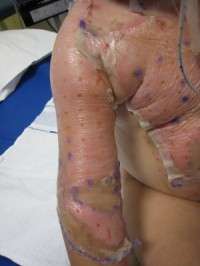A child suffering from 32 per cent burns from a cup of tea. Credit: North Bristol NHS Trust
A pioneering method for fighting burn infections in children using viruses which destroy disease-causing bacteria has been awarded new funding.
It is hoped the project will develop a burns dressing that will prevent and treat ‘superbugs’ that have become resistant to antibiotics – without the use of antibiotics or synthetic antimicrobials.
Scientists from Bristol’s Frenchay hospital, the University of Bath and AmpliPhi Biosciences in Bedfordshire are harnessing bacteriophages – viruses which kill bacteria.
The project has now been awarded a grant of £620,000 from the Engineering and Physical Sciences Research Council (EPSRC) to develop a prototype dressing.
Half of all burn injuries occur in children, and most of these are due to scalds from hot tea, coffee and bath water.
Around 10 percent of children who are burnt become infected by disease-causing bacteria which can increase the likelihood of scarring and in some cases even cause death.
In the last year the South West UK Children’s Burn Center at Frenchay Hospital in Bristol has treated more than 800 children for serious burn injuries.
Current treatments for infections use chemical antibiotics but bacteria are rapidly evolving resistance to such drugs.
University of Bath project leader Dr. Toby Jenkins said: “The fact that bacteria are becoming more and more resistant to antibiotics is extremely worrying.
“There is an arsenal of drugs at our disposal to treat children with infected burn wounds, but in recent years there have been an increasing number of cases where antibiotics prove ineffective due to bacterial antibiotic resistance. In some cases of infection no antibiotics will be effective in treatment.
“This is a very serious situation and a great deal of innovation is required in the way we treat infections.
“The answer, we believe, lies in a radical new approach to treating infection using natural bacteria-killing viruses.”
Bacteriophages have already been shown to be safe and effective in a recent clinical trial in patients with chronic ear infections, carried out by AmpliPhi’s wholly-owned subsidiary Biocontrol Ltd.
Professor Mark Enright, AmpliPhi’s Research Director, told us “These phages are naturally occurring and safe as they only ever infect their target species of bacteria.
“They enter their host, reproduce and then burst out and then go on to kill more bacteria. Once all the infection-causing bacteria are consumed the phages simply die.
“Our company is targeting antibiotic resistant bacteria in a number of projects with the aim of producing safe and effective therapies that are subjected to the same type of clinical trials and regulations as new drugs.”
Dr. Amber Young, a paediatric burn specialist at the South West UK Children’s Burn Centre, a clinical consultant and partner on the project, said: “Of the 37,000 scald accidents in the UK each year, nearly 76 percent are children under five, and 70 percent are caused by hot liquids being split.
“180 children every day are seen in accident and emergency departments with scalds from hot drink spillage alone.
“The terrible truth is that even a very small burn can very quickly become infected, and the child can become seriously ill.
“This funding award is absolutely essential for the research team to develop this product, so it’s a really positive step forward in the field of paediatric burn treatment.”
Dr. Jenkins aims to introduce phage into burns using advanced dressings, covered with ‘nanocapsules’ used to contain and stabilize the phage.
Dr. Jenkins said: “This is as part of a wider research interest looking at making very advanced burns dressings which monitor the burn environment and treat infection.
“Ultimately we want to make a prototype dressing which release a phage ‘cocktail’ into the wound only if infected, clearing bacteria and allowing healing. The dressing will also change colour indicating infection at very early stages”.
Dr. Jenkins’ colleague Dr. Tom Arnot is developing large scale methods of producing the nanocapsules, and for incorporating the nanocapsules into a gel formulation for topical application to the skin.
Dr. Arnot said: “Different burns require different approaches to treatment, so developing a gel for topical skin application in addition to the wound dressing would allow this unique technology to be applied under a wider range of circumstances. We are also looking at the engineering and production aspects of formulating this type of preparation at larger scale”
The EPSRC funding award will allow the team to develop prototype dressings, undertake microbial analysis and begin preclinical trials, with the aim of commencing clinical trials at the end of the project.
Provided by University of Bath





















